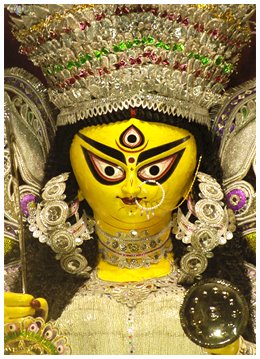Agamani.
Several mythological legends underlie the Durga Puja festival. One of these is the legend that every year during the Navaratri, Goddess Uma, who is identified with Parvati the divine consort of Shiva, comes to the home of her parents – Himavat and Menaka. In Bengal this legend has been universalized into the belief that the Divine Mother visits the homes of all her children during the three days of Durga Puja. Agamani songs are songs which vividly depict the maternal love and deep concern of Menaka for her divine daughter. They are sung to welcome Mother Uma into homes. They also reflect parents’ love for their married daughters.
Swami Vivekananda was fond of Agamani songs because of the tender feelings expressed in them. On the Shashthi of the first Durga Puja at Belur Math, Swamiji sang Agamani songs such as, Giri Ganesh amar shubhakari etc. The tradition of singing Agamani songs continues in Belur Math. Every year from the first day (pratipada) after Mahalaya to the sixth day (Shashthi) Sadhus and Brahmacharins gather at the main temple of Sri Ramakrishna at dawn and sing Agamani songs in chorus. [At night, after Arati, they conduct Kalikirtan.]
Chandipath.
During the nine days of Navaratri the book Chandi is recited everyday morning. This recital is done along with worship of the Goddess Chandi. In Belur Math this is done during the first five days at a corner of Natamandir and from the 6th at a corner of Durga Mandap itself.
Shashthi : the 6th day (2nd October)
This is a very important day when ritual preparations are made to begin the Durga Puja proper. These preparations are mainly three: Kalparambha, Bodhan, Adhivas and Amantran.
Kalparambha.
This ritual is done early in the morning. It is mainly an act of making the sankalpa or ”sacramental intention”, the firm determination to conduct the Puja properly during the three days. The ritual consists of installing the ghata, water-filled copper pot, at a corner of Durga mandap and offering worship to Durga and Chandi.
Bodhan.
This rite is performed at the Sandhya or dusk. The word ‘Bodhan’ literally means ‘awakening’. As already mentioned elsewhere, the Hindu mythology holds that all gods and goddesses go to sleep for six months during the southward journey of the Sun. Autumn (Sharat), during which Durga Puja is done, falls in the middle of this period. Hence it is necessary to first of all awaken the deity Durga. We have already mentioned that the awakening of Durga was first done by Sri Ramachandra who wanted to propitiate the Goddess before fighting Ravana.
The ritual of Bodhan consists in installing a water-filled copper vessel at the base of the Bel (Bilva) tree (or, as is now done at Belur Math, keeping a branch of the Bel tree in the pot) and praying to the Divine Mother to awaken.
The ritual of Bodhan consists in installing a water-filled copper vessel at the base of the Bel (Bilva) tree (or, as is now done at Belur Math, keeping a branch of the Bel tree in the pot) and praying to the Divine Mother to awaken.
Adhivas and Amantran.
These rites follow Bodhan. Adhivas means ”invocation”. Through Bodhan the Devi has awakened: now the awakened Devi has to be invoked in the Bel tree or branch of the tree. Adhivas is also a ritual of sanctification. The actual ritual consists of the following main steps.
Devi Durga and the Bel tree are first worshipped.
Twenty-six sacramental things (mangalik dravya) are sanctified by touching Devi Durga and the Bel tree with them.
To ward off evil effects, a red coloured thread is tied around the altar where Puja is done.
The above ritual is followed by Amantran which literally means ”invitation”.
Through this ritual the Devi is invited or entreated to accept the Puja the next day (Saptami).
After this, Devi is worshipped with five items and Arati is waved before Her.







